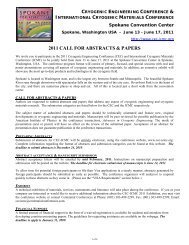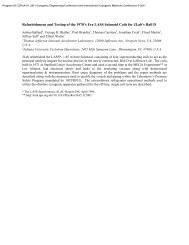CEC Abstracts in PDF format (as of 7/3/07) - CEC-ICMC 2013
CEC Abstracts in PDF format (as of 7/3/07) - CEC-ICMC 2013
CEC Abstracts in PDF format (as of 7/3/07) - CEC-ICMC 2013
You also want an ePaper? Increase the reach of your titles
YUMPU automatically turns print PDFs into web optimized ePapers that Google loves.
<strong>CEC</strong> 20<strong>07</strong> - <strong>Abstracts</strong><br />
C2-R-04 Open cycle Joule-Thomson cryocool<strong>in</strong>g with<br />
prior sequential isentropic expansion<br />
B-Z. Maytal, Rafael.<br />
The high pressure stream outlets a g<strong>as</strong> reservoir and expands through<br />
a loaded turb<strong>in</strong>e prior to be<strong>in</strong>g fed <strong>in</strong>to a Joule-Thomson (J-T)<br />
cryocooler. Due to the load and accord<strong>in</strong>g to its extent, the g<strong>as</strong> drops<br />
its pressure through the turb<strong>in</strong>e at a constant entropy process. On the<br />
one hand, the g<strong>as</strong> that <strong>in</strong>lets the J-T cryocooler is <strong>of</strong> lower pressure<br />
than without a turb<strong>in</strong>e. This effect suppresses the <strong>in</strong>tegral isothermal<br />
J-T effect which is the specific cool<strong>in</strong>g capacity <strong>of</strong> the stream. On the<br />
other hand, the isentropic expansion is accompanied by temperature<br />
reduction which elevates the specific cool<strong>in</strong>g capacity. This effect<br />
dom<strong>in</strong>ates the former one thus consequently; the specific cool<strong>in</strong>g<br />
capacity is enhanced even when the high pressure g<strong>as</strong> reservoir stays<br />
isothermal. The isentropic expansion is always accompanied by a<br />
temperature drop which is quite substantial. Therefore, the expanded<br />
very first cooled stream <strong>in</strong>lett<strong>in</strong>g the J-T cryocooler may significantly<br />
accelerates the cooldown process.. This beneficial performance <strong>of</strong> the<br />
serial arrangement <strong>of</strong> a turb<strong>in</strong>e and a J-T cryocooler is analyzed and<br />
formulated for argon and nitrogen accord<strong>in</strong>g to any load<strong>in</strong>g policy <strong>as</strong><br />
for <strong>in</strong>stance, dropp<strong>in</strong>g the pressure at the turb<strong>in</strong>e by a predeterm<strong>in</strong>ed<br />
constant factor.<br />
C2-S Superconduct<strong>in</strong>g Cables<br />
C2-S_01 The Latest Status <strong>of</strong> A Long Term In-grid<br />
Operation <strong>in</strong> Albany HTS Cable Project<br />
H. Yumura, T. M<strong>as</strong>uda, M. Watanabe, H. Takigawa,<br />
Y. Ashibe, H. Ito, M. Hirose, K. Sato, Sumitomo<br />
Electric, Industries, Ltd.<br />
The HTS cable system is expected to be a solution for improvement <strong>of</strong><br />
the power grid, and three demonstration projects <strong>in</strong> the real grid have<br />
been carry<strong>in</strong>g out <strong>in</strong> the United States. The Albany Cable Project, one<br />
<strong>of</strong> them, is to develop the 350 meters long HTS cable system with<br />
capacity <strong>of</strong> 34.5kV, 800A, connect<strong>in</strong>g between two substations <strong>in</strong><br />
National Grid Power Company`s grid.<br />
A 320-meter and a 30-meter cable are <strong>in</strong>stalled <strong>in</strong>to underground<br />
conduit and jo<strong>in</strong>ted each other at a vault. The cable w<strong>as</strong> fabricated<br />
with Di-BSCCO wire total amount <strong>of</strong> 70km and h<strong>as</strong> the structure <strong>of</strong> 3<br />
cores-<strong>in</strong>-one cryostat. The cable <strong>in</strong>stallation <strong>of</strong> a 320-meter and a 30-<br />
meter section w<strong>as</strong> completed successfully with us<strong>in</strong>g the same pull<strong>in</strong>g<br />
method <strong>of</strong> a conventional cable. After cable <strong>in</strong>stallation, the jo<strong>in</strong>t and<br />
two term<strong>in</strong>ations were <strong>as</strong>sembled at the test site. After the <strong>in</strong>itial<br />
cool<strong>in</strong>g <strong>of</strong> the system, the completion tests such <strong>as</strong> the critical current,<br />
heat loss me<strong>as</strong>urement and DC withstand voltage test were conducted<br />
successfully.<br />
The <strong>in</strong>-grid operation w<strong>as</strong> begun on 20th <strong>of</strong> July, 2006. And a long<br />
term <strong>in</strong>-gird operation h<strong>as</strong> been progressed satisfactorily at unattended<br />
condition. In the Albany project, the 30-meter section is planed to be<br />
replaced to YBCO cable <strong>in</strong> this spr<strong>in</strong>g. The development <strong>of</strong> YBCO<br />
cable h<strong>as</strong> been carried out by us<strong>in</strong>g SuperPower’s YBCO coated<br />
conductors. This paper describes the latest status <strong>of</strong> the Albany cable<br />
project.<br />
C2-S-02 Deveopment <strong>of</strong> YBCO Cable for Albany HTS<br />
Cable Project<br />
H. Yumura, M. Ohya, Y. Ashibe, H. Ito, T. M<strong>as</strong>uda, K.<br />
Sato, Sumitomo Electric Industries, Ltd.<br />
The Albany Cable Project is to develop the 350 meters long HTS<br />
cable system with capacity <strong>of</strong> 34.5kV, 800A, connect<strong>in</strong>g between two<br />
substations <strong>in</strong> National Grid Power Company`s grid.<br />
In-grid operation with BSCCO HTS cable w<strong>as</strong> begun on 20th <strong>of</strong> July,<br />
2006, successfully. And a long term <strong>in</strong>-gird operation h<strong>as</strong> been<br />
progressed satisfactorily at unattended condition. The BSCCO cable<br />
l<strong>in</strong>e consists <strong>of</strong> a 320-meter, a 30-meter cable, cable-to-cable splice <strong>in</strong><br />
vault and two term<strong>in</strong>ations. In the Albany project, the 30-meter<br />
section is planed to be replaced to YBCO cable <strong>in</strong> this spr<strong>in</strong>g. The<br />
development <strong>of</strong> YBCO cable h<strong>as</strong> been carried out by us<strong>in</strong>g<br />
SuperPower’s YBCO coated conductors. The YBCO sample core w<strong>as</strong><br />
fabricated and evaluated its electrical and mechanical properties <strong>in</strong><br />
order to confirm the cable design. The critical current <strong>of</strong> conductor<br />
and shield were approx. 1.4 kA and 2.0 kA, respectively. They are<br />
almost same <strong>as</strong> design value consider<strong>in</strong>g with tape’s Ic and the effect<br />
<strong>of</strong> magnetic field. The ac loss <strong>of</strong> the sample w<strong>as</strong> 0.4 W/m/ph at 800<br />
Arms <strong>of</strong> 60Hz. The fault current test, 23kA and38cycles, w<strong>as</strong><br />
conducted under open bath condition. The temperature rises at<br />
conductor and shield were almost same <strong>as</strong> the ones <strong>of</strong> BSCCO core,<br />
and no Ic degradation w<strong>as</strong> found after the fault current test. This paper<br />
describes the detail <strong>of</strong> test results for YBCO sample core and design<br />
<strong>of</strong> YBCO cable for Albany Project.<br />
C2-S-03 A Cool<strong>in</strong>g System for Navy Degauss<strong>in</strong>g Cables<br />
J. Yuan, J. Maguire, D. Aized, A. Covel, American<br />
Superconductor Co.<br />
Degauss<strong>in</strong>g cables are a vital part <strong>of</strong> today’s military ships.<br />
Degauss<strong>in</strong>g cables are utilized <strong>in</strong> most navy ships to reduce their<br />
magnetic signature, thereby mak<strong>in</strong>g them much more difficult to be<br />
“seen” by magnetic sensors and by magnetically activated m<strong>in</strong>es.<br />
Current degauss<strong>in</strong>g systems consist <strong>of</strong> a series <strong>of</strong> field-generat<strong>in</strong>g<br />
loops and their <strong>in</strong>stallation <strong>in</strong>volves runn<strong>in</strong>g heavy copper cables<br />
around the perimeter <strong>of</strong> the ship’s hull. High Temperature<br />
superconductor-b<strong>as</strong>ed degauss<strong>in</strong>g cables provide many benefits <strong>as</strong> a<br />
replacement for conventional, copper-b<strong>as</strong>ed degauss<strong>in</strong>g systems,<br />
<strong>in</strong>clud<strong>in</strong>g lighter weight, lower operat<strong>in</strong>g voltage, lower <strong>in</strong>stallation<br />
costs, higher energy efficiency and smaller size. In March 2006,<br />
AMSC announced that it had demonstrated the successful operation <strong>of</strong><br />
the world’s first full-scale HTS degauss<strong>in</strong>g cable for military ships.<br />
The 40 meter long HTS degauss<strong>in</strong>g cable produced 4100 Amp-turns<br />
with a significant decre<strong>as</strong>e <strong>in</strong> operat<strong>in</strong>g voltage to less than 0.5 volts,<br />
or 1000 times lower than a comparable Amp-turn copper-b<strong>as</strong>ed<br />
system. The system h<strong>as</strong> been cont<strong>in</strong>u<strong>in</strong>g runn<strong>in</strong>g s<strong>in</strong>ce March, 2006.<br />
This paper reviews the test<strong>in</strong>g <strong>of</strong> the degauss<strong>in</strong>g cable, along with a<br />
comparison between the simulation and experiments.<br />
C2-S-04 Performance Test <strong>of</strong> Cool<strong>in</strong>g System for KEPCO<br />
HTS Power Cable<br />
H.S. Yang, D.L. Kim, B.S. Lee, Y.S. Choi, Korea B<strong>as</strong>ic<br />
Science Institute; S.H. Sohn, J.H. Lim, Korea Electric<br />
Power Research Institute; H.S. Ryoo, S.D. Hwang,<br />
Korea Electrotechnology Research Institute.<br />
A cool<strong>in</strong>g system for a 3-ph<strong>as</strong>e 100m HTS power cable with<br />
22.9kV/1.25kA w<strong>as</strong> <strong>in</strong>stalled and tested at KEPCO’s Gochang power<br />
test<strong>in</strong>g center <strong>in</strong> Korea. The system consists <strong>of</strong> a liquid nitrogen<br />
decompression cool<strong>in</strong>g system with a cool<strong>in</strong>g capacity <strong>of</strong> 3kW at 66K<br />
and a closed circulation system <strong>of</strong> subcooled liquid nitrogen. Several<br />
performance tests <strong>of</strong> the cable system with respect to the cool<strong>in</strong>g such<br />
<strong>as</strong> heat load, AC loss and temperature stability, were performed at<br />
operat<strong>in</strong>g temperature <strong>of</strong> 66.4K. Thermal cycle test, cool-down to<br />
liquid nitrogen temperature and warm-up to room temperature, w<strong>as</strong><br />
also performed to <strong>in</strong>vestigate thermal cycle <strong>in</strong>fluences. The outl<strong>in</strong>e <strong>of</strong><br />
the <strong>in</strong>stalled cool<strong>in</strong>g system and performance test results are presented<br />
<strong>in</strong> this paper.<br />
This research w<strong>as</strong> supported <strong>in</strong> part by the Electric Power Industry<br />
Technology Evaluation & Plann<strong>in</strong>g <strong>of</strong>fice, Republic <strong>of</strong> Korea.<br />
Page 34 <strong>of</strong> 53






